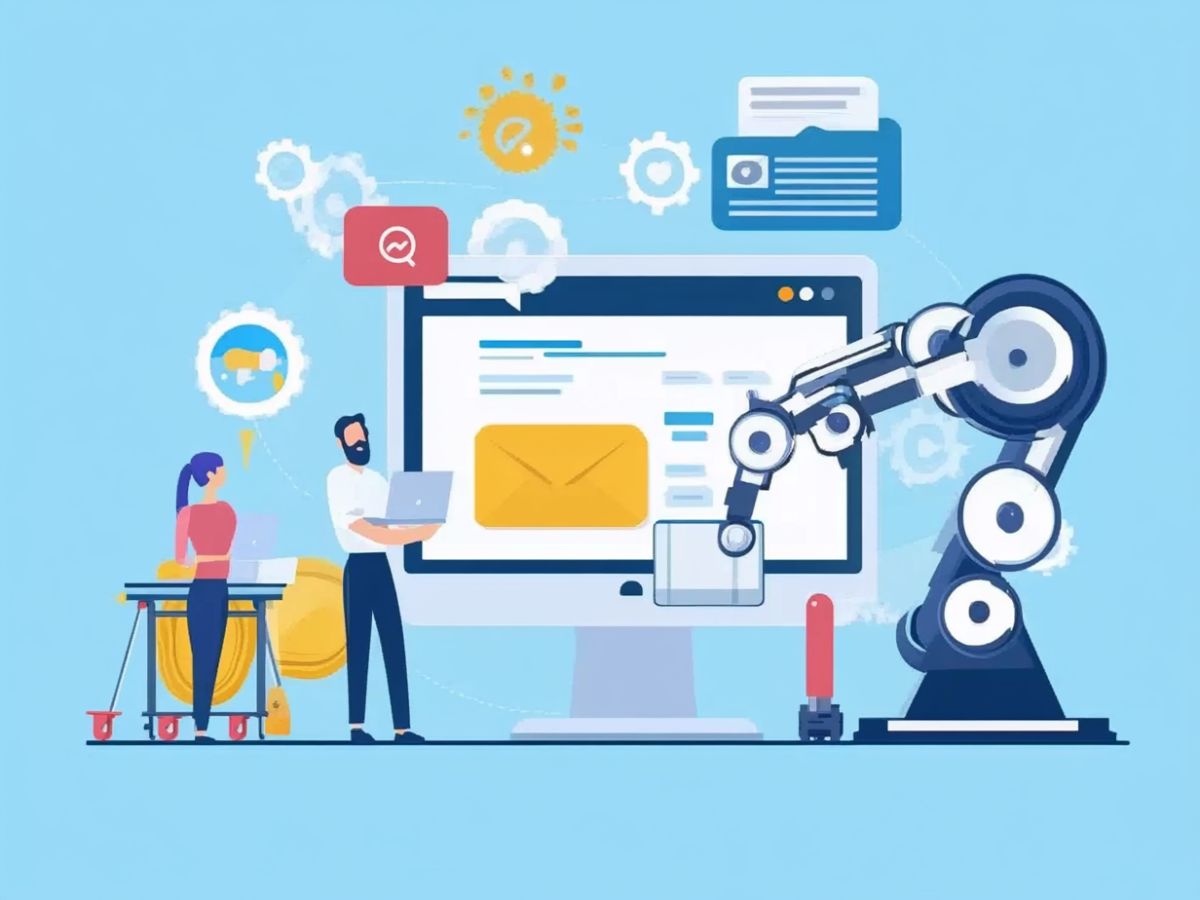What is marketing automation?
In a world flooded with digital noise, how do brands reach the right customer at the right time — without burning out their marketing teams? Marketing automation is the answer.
It’s the technology that helps businesses optimize, automate, and measure their marketing efforts—allowing them to learn from feedback, increase efficiency, and grow revenue faster.
But what is Marketing automation? It refers to software platforms and technologies designed for marketing departments and organizations to more effectively market on multiple channels (like email, web, social media, SMS) and automate repetitive tasks.
It involves:
- Email workflows – Automated email sequences triggered by specific customer actions. (e.g., welcome series, abandoned cart reminders, transactional email)
- Lead nurturing and scoring – Automatically engaging leads over time and ranking them based on behavior and engagement.
- Lead capturing – Collecting contact information from potential customers through forms, pop-ups, or gated content.
- Audience segmentation – Dividing your audience into groups based on behavior, demographics, or engagement level.
- Omnichannel campaigns – Coordinating messages across multiple channels like push notifications, SMS, WhatsApp, and even direct mail.
- Campaign analytics and reporting – Tracking how customers interact with your messages and website to optimize future campaigns.
There are many marketing automation platforms that can handle all the key aspects of modern marketing — from lead capturing and email workflows to segmentation, omnichannel messaging, and analytics. Be sure to choose a platform that aligns with your business goals, technical expertise, and growth stage. A tool that’s too complex can slow you down with unnecessary overhead, while one that’s too basic might limit your ability to scale effectively.
Why Use Marketing Automation?
Marketing automation has gone mainstream among companies in recent years. Roughly three-quarters of businesses now use marketing automation tools to manage customer outreach and campaigns. Even among those not yet using it, 26% plan to adopt automation in the near future.
The primary goal of marketing automation is to enhance and simplify communication with customers. By collecting and analyzing customer data from various channels, businesses can understand their customers’ behaviors and preferences, allowing them to engage on a more personal level. This is essential for businesses looking to enhance efficiency, improve customer engagement, better lead capture and drive better results from their marketing efforts.
Benefits of Marketing Automation
Organizations report a range of tangible benefits after implementing marketing automation, from higher ROI to improved efficiency. Key advantages include:
1. Efficiency and Cost Savings
Automating repetitive marketing tasks greatly improves team efficiency. About 74% of marketers say automation saves them significant time by handling routine tasks like email sends, social posting, and audience segmentation. This productivity impact translates to hard savings – studies show marketing automation can lead to a 12.2% increase in sales productivity and a 14.5% reduction in marketing overhead costs on average. Freed from manual workflows, marketing teams can focus on strategy and creative work, while automation optimizes the execution.
2. Enhanced Customer Analysis
Marketing automation tools enable businesses to analyze customer data at scale. You can categorize customers by age, interests, and shopping habits, allowing for targeted and personalized communication. Integrating marketing automation with a CRM platform enhances these capabilities, helping you track customer interactions and preferences more effectively.
3. Segmentation
Segmentation plays a key role in making marketing more relevant and effective. By grouping customers based on shared characteristics (e.g., location, interests), you can tailor your messaging and timing to each segment. Automated email campaigns, such as drip campaigns, ensure that customers receive the right message at the right time.
5. Increased Efficiency and ROI
About 74% of marketers say automation saves them significant time by handling routine tasks like email sends, social posting, and audience segmentation. Marketing automation enables businesses to achieve more with less effort, leading to higher efficiency and better returns on investment. By automating personalized marketing efforts, your team can spend more time on other critical aspects of the business. On average, companies earn about $5.44 for every $1 spent on automation (a 544% ROI). Most brands don’t wait long to see gains – 76% of companies achieve a positive ROI within the first year of adopting marketing automation
6. Increased Leads and Conversions
Automation helps capture and convert more customers. 80% of marketing automation users saw an increase in lead volume, and 77% experienced higher conversion rates after implementation. For example, automated email campaigns generate far better results than manual sends – they can achieve 84% higher open rates and 341% higher click rates, driving a disproportionate share of online orders. By nurturing prospects with timely, personalized messages, B2C brands boost their sales funnel performance.
7. Better Customer Retention
Many B2C companies also credit automation for strengthening customer relationships. By delivering more consistent and relevant communications, brands see improved loyalty and retention. In fact, 58% of marketers using automation report improved customer retention and satisfaction metrics after personalizing their outreach. Automated follow-ups (like post-purchase emails, re-engagement campaigns, birthday offers, etc.) help keep customers engaged and coming back, directly impacting lifetime value.
AI and Machine Learning in B2C Marketing Automation
Advanced technologies like artificial intelligence are reshaping how B2C marketers personalize and optimize campaigns. Gartner predicts that by 2024, 60% of B2C companies will rely on AI-driven personalization to enhance customer experiences. Marketers are already seeing the impact of AI in their automation efforts – in one survey, 63% of marketers said using AI in marketing automation improved their targeting and segmentation. These tools analyze customer data in real time to tailor content for each individual. The payoff is significant: over half of companies using AI-powered automation report higher conversion rates due to improved personalization. High-performing brands are especially bullish on AI: roughly 70% of top-performing companies are investing in AI-enabled marketing automation tools to gain an edge. In the retail sector (a key B2C domain), nearly half of companies are now using AI for marketing automation tasks – from predictive product recommendations to chatbot assistants. Overall, AI and machine learning have become integral to B2C marketing automation, powering smarter personalization engines and predictive analytics that boost campaign effectiveness.
How to Apply Marketing Automation to Your Business
To effectively implement marketing automation, you need to rely on data. Each interaction a prospect has with your business—whether they make a purchase, subscribe to your email list, or click on an ad—provides valuable information. This data can be used to tailor marketing messages and automate the delivery of personalized content.
Common applications of marketing automation include:
- Email Automation: Automate tasks such as sending welcome emails, abandoned cart reminders, and follow-up messages based on customer behavior. This ensures timely and relevant communication that nurtures leads and encourages conversions.
- SMS and Push Notifications: Automate the delivery of SMS and push notifications to keep customers engaged with timely updates, special offers, and important alerts, directly on their mobile devices.
- Social Media Scheduling: Schedule posts in advance and use automated tools to manage customer interactions.
- Retargeting: Use automation to send follow-up emails to customers who abandon their carts, encouraging them to complete their purchase.
- Customer Journey Mapping: Track customer behavior to predict future actions and tailor marketing efforts accordingly.
- Campaigns and journeys: In marketing automation platforms like Salesforce Marketing Cloud (SFMC), Adobe Campaign, Braze, Bloomreach, and many others, you can create complex automated campaigns or journeys that guide customers through a sequence of actions based on their behaviors. For example, you can set up a campaign where if a customer opens Email 1, they receive Email 2, but if they don’t open Email 1, they receive a follow-up reminder. If they click on a specific CTA, you can send them more information on the relevant topic. Additionally, if their email address is not deliverable, you can use another channel to reach out to the customer with a specific marketing message. This type of automation allows for highly customized and responsive marketing strategies, ensuring that each customer receives the most relevant content at the right time.
- A/B Testing: Use A/B testing to optimize email content, landing pages, and other marketing materials, ensuring the best possible outcomes.
Marketing Automation and Customer Experience
Marketing automation enhances customer experience by ensuring that communication is timely, relevant, and personalized. It helps businesses stay connected with customers throughout their journey, from awareness to purchase, and even re-engagement.
By setting up automated systems that send relevant content or promotions, you can build trust with your audience. Customers will appreciate receiving valuable information and offers that are tailored to their needs and interests.
Best Practices for Marketing Automation
1. Set Clear Goals: As in other industries, we need to measure our progress. The best approach is to define specific, measurable goals for your marketing automation efforts and use data to track progress and make adjustments as needed.
2. Know Your Audience: Segment your audience based on demographics, interests, and behaviors to ensure that your automated messages are relevant and engaging.
3. Personalize Communication: Use personalized content to send messages that resonate with your audience, improving engagement and conversion rates.
4. Optimize Through Testing: Continuously test and optimize your automated campaigns using A/B testing and other methods to ensure the best possible outcomes.
5. Focus on Customer Retention: Use automation to nurture existing customers, offering personalized experiences and rewards to build loyalty and encourage repeat business.
External resources
- 80 Must-Know Marketing Automation Statistics to Supercharge Your Campaigns in 2024
- Top 30 Marketing Automation Statistics For 2025: ROI, Trends & More
- 31+ Marketing Automation Statistics & Trends (2024)
- https://blog.flarelane.com/cross-channel-marketing-trends-for-b2c-businesses-in-2024
- AI in eCommerce Statistics

















